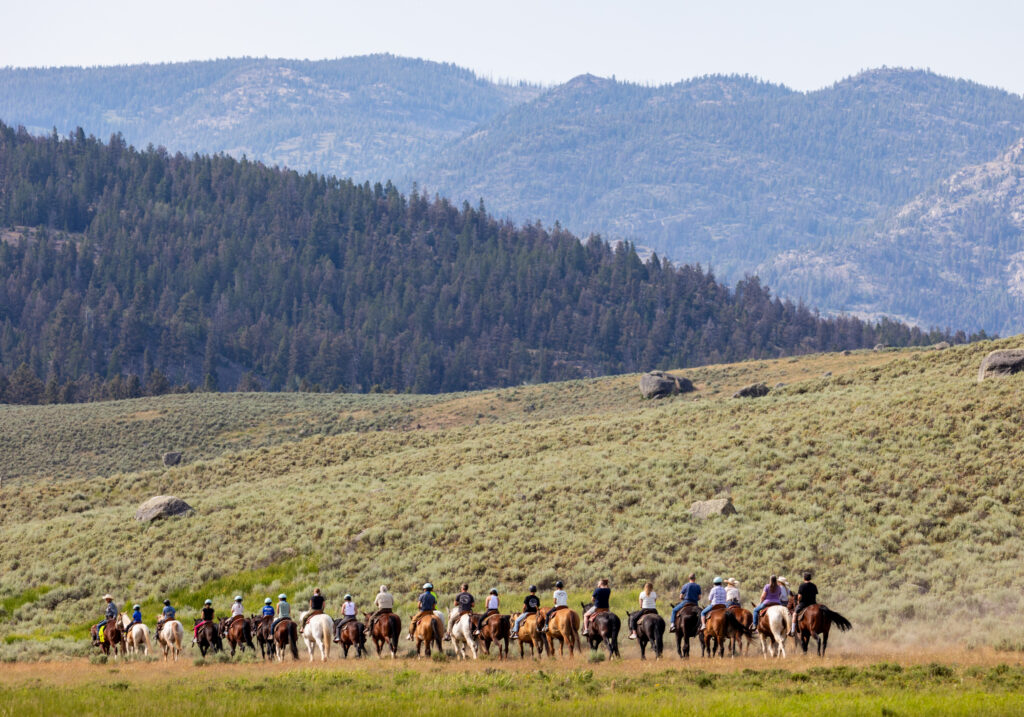Trail riders head out on horseback on July 9, 2024, at Yellowstone National Park. (Pat Sutphin for the Idaho Capital Sun)
An impressive array of technologies is used to monitor geological activity in Yellowstone National Park, including some that make use of satellites. Each technology complements the others, filling in its portion of the big picture that helps us understand magmatic, tectonic and hydrothermal activity associated with the caldera system. And sometimes they even can be used to improve other techniques.
One of those technologies is InSAR — a technique that uses radar data, often acquired by satellites, to measure motion of the ground. An InSAR satellite bounces radar waves off the Earth’s surface, measuring the characteristics of the wave as they return to the satellite. But the real magic is in doing this repeatedly, every time the satellite orbits over that area. Carefully comparing one pass to another provides a measure of ground movement caused by, for example, an earthquake or a pressure change within a volcano, between the times the satellite was overhead.
This is a graphic showing how InSAR detects ground deformation by measuring changes in the signal that bounces off the Earth. (Courtesy of the EarthScope Consortium)
A number of radar satellites acquire data over Yellowstone — like the European Space Agency’s Sentinel-1 mission, which collects images from the region every week or two. A new satellite mission is soon set to join the fun. Currently slated for launch in early 2025, the NISAR mission is a joint effort between NASA and the Indian Space Research Organization. And the mission has some unique capabilities that will be of use in places like Yellowstone.
The wavelength of radar waves used to image the surface makes a difference for how well these satellites can measure different processes, and NISAR will be the first to have two wavelengths rather than just one. In addition to measuring ground movement with InSAR, the radar data will be used to track glaciers, sea ice, snowpack, water resources, soil moisture and vegetation, including agriculture. That is a lot of information to be extracted from some radar waves bouncing off the Earth!
For existing satellites and the coming NISAR satellite, an effort at NASA’s Jet Propulsion Laboratory is working to improve scientists’ ability to use all these data to do things like monitor Yellowstone. This project plans to build new standardized datasets that combine different satellite missions, simplifying the process of accessing and processing data from different sources. These datasets will include important capabilities, for instance, mapping surface water coverage, detecting disturbances like wildfires, and measuring ground movement.
And that brings us back around to how some monitoring technologies used in Yellowstone can “team up” and complement one another. A number of GPS stations in Yellowstone used to track ground motion are part of much larger effort called the Network of the Americas, which is generating data that are being used to calibrate the new satellite measurements.
Part of the Jet Propulsion Laboratory effort involves corner reflectors that have been placed out in specific locations. They may look like art installations, but these corner reflectors have been engineered to produce bright reflections in the satellite radar data — just as you will see a bright reflection when shining a flashlight toward a mirror.
A corner reflector, designed to reflect satellite radar signals and useful for calibrating radar data, with GPS station PEA1 (and the San Andreas fault) in the background. (Scott Johnson/EarthScope Consortium)
Several of these corner reflectors were installed on opposite sides of the San Andreas fault near Parkfield, California, right next to existing GPS stations. This makes it easy to know the exact location of the corner reflector over time. The Jet Propulsion Laboratory team will compare the locations as measured by GPS stations to the locations as measured by radar satellites like NISAR to ensure that the data are being processed accurately — and that the satellites are faithfully measuring the gradual movement of the San Andreas fault. That will help ensure that the satellites are accurately measuring other kinds of ground deformation, like the subtle vertical and horizonal movements in Yellowstone National Park.
A constant churn of hard work behind the scenes is required to ensure that we can get the most out of the systems used to monitor hazards in Yellowstone. This particular effort is a good reminder that a monitoring system composed of multiple, complementary technologies is much more robust than a system that can only measure one thing in one way. They build upon each other, with each addition upgrading the overall system’s effectiveness. When the new NISAR satellite joins the team — with a little help from its friends — there will be another eye in the sky watching over Yellowstone, giving us a little more information than we had before.

